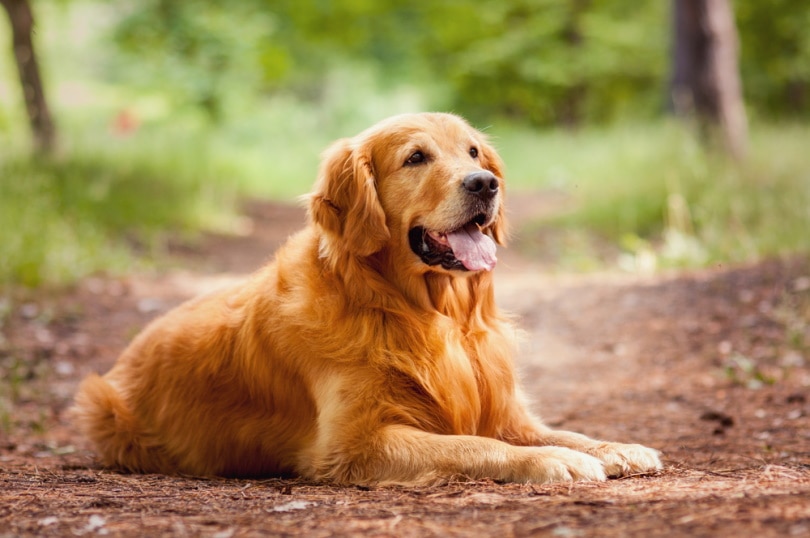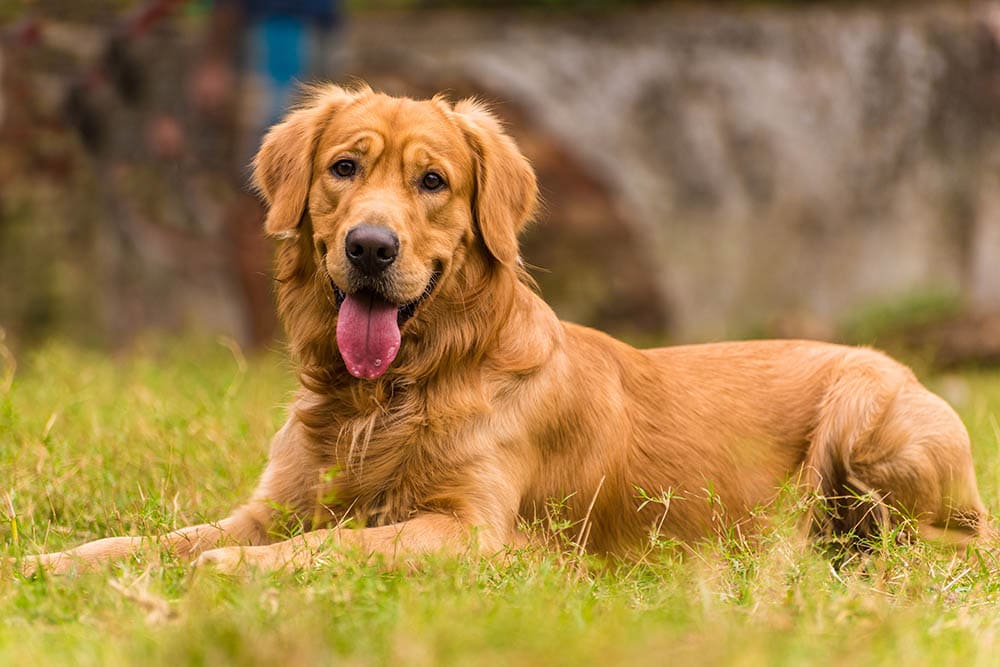Click Below to Skip Ahead
Golden Retrievers, often referred to as Goldens for short, are beloved family pets often featured in movies and shows. You’ll also see them on search and rescue missions and as service animals. Why do we see them so often? They are a good-natured breed and never really grow out of their fun and playful ways, but they are incredibly loyal, intelligent, and easy to train.
If you are considering a Golden Retriever puppy, you may be interested in how big it will get and what factors ultimately affect its size.

Facts About Golden Retrievers
Goldens are among the most popular dog breeds, especially for families, because of their playful and loyal nature. Here are a few facts about Goldens you may not have known:
- Goldens are the 4th most intelligent dog breed and are easily trained.
- Their double coat repels water, and they love to swim.
- They love caring for others (puppies, humans, and even cats!)
- They are superior tracking dogs and a popular choice for search and rescue.

Golden Retriever Size and Growth Charts
Male Goldens have a stockier build, a broader head and snout, and a prominent tuft of hair under the chin and down the chest, sometimes called a mane. You may be able to spot a female Golden by their slender body profile, narrower head, and thinner, more feathered coat appearance.
Because of their natural size differences, male and female Golden Retrievers have slightly different growth charts.
Golden Retriever Size and Growth Chart (Male)
| Age | Weight Range (pounds) | Length Range (inches) |
| 8 weeks | 3-17 lbs. | 6″–15″ |
| 9 weeks | 5-17 lbs. | 9″–15″ |
| 10 weeks | 8-22 lbs. | 10″–15″ |
| 11 weeks | 12-25 lbs. | 10″ -15″ |
| 3 months | 16-43 lbs. | 10″–20″ |
| 4 months | 25-44 lbs. | 12″–24″ |
| 5 months | 27-57 lbs. | 13.5″–24″ |
| 6 months | 29-72 lbs. | 19″–24.5″ |
| 7 months | 32-77 lbs. | 19″–26″ |
| 8 months | 49-85 lbs. | 21″–26″ |
| 9 months | 45-77 lbs. | 22″–26″ |
| 10 months | 50-77 lbs. | 22″–26″ |
| 11 months | 55-77 lbs. | 22″–26″ |
| 1 year | 65-77 lbs. | 22″–26″ |
| 2 years | 65-80 lbs. | 22″–26″ |
Golden Retriever Size and Growth Chart (Female)
| Age | Weight Range | Length Range |
| 8 weeks | 5-17 lbs. | 6″–15″ |
| 9 weeks | 8-17 lbs. | 9″–16″ |
| 10 weeks | 19-22 lbs. | 11″–8″ |
| 11 weeks | 12-25 lbs. | 11″–18″ |
| 3 months | 16-33 lbs. | 11″–19″ |
| 4 months | 22-44 lbs. | 12″–22″ |
| 5 months | 25-52 lbs. | 13″–24″ |
| 6 months | 27-61 lbs. | 15″–24″ |
| 7 months | 31-67 lbs. | 16″–25″ |
| 8 months | 40-70 lbs. | 18″–25″ |
| 9 months | 44-68 lbs. | 20″–25″ |
| 10 months | 52-68 lbs. | 20″–25″ |
| 11 months | 52-80 lbs. | 20″–25″ |
| 1 year | 55-90 lbs. | 20″–26″ |
| 2 years | 55-90 lbs. | 20″–26″ |
When Does a Golden Retriever Stop Growing?
Goldens will reach their full adult size by the time they are 2 years old. They may have reached their adult height much earlier than that, at around one year, but it takes another year to build the strong bones and muscle they will need throughout adulthood.
By the time they are two, Golden Retrievers may not continue growing physically, but they still have some growing up to do mentally. Regular training is essential for a well-behaved pup, even if your Golden always retains the youthful playfulness the breed is known for.

Factors Affecting the Size of Golden Retriever
As you can see from the growth charts above, the size and weight of your pup can vary widely. What determines how big your Golden will get? Just as with all puppies, the quality of their food, the proper amount of exercise, and their genetics all play a role in their adult size.
Proper veterinary care throughout their lifetime is essential but is most likely to affect their growth as puppies. Be sure to:
- Check for, treat, and prevent parasites
- Get all vaccines and boosters on time
- Consider the time of spaying or neutering
Purebred Goldens are susceptible to rare pituitary dwarfism that affects their hormones and growth. Your vet can check for this if your pup isn’t meeting growth milestones.
Retriever mixed breeds will have a much different growth chart based on their parentage. Be sure to research the mixed breed features and parentage to know more about what to expect.
Ideal Diet for Maintaining a Healthy Weight
Goldens require a diet with healthy protein from an animal source, typically beef, poultry, or fish. Omega-3 fatty acids provide energy and support the absorption of vitamins, minerals, and other nutrients. Prebiotics and fiber from fruits and vegetables aid digestion and may help avoid bowel problems.
A quality dog food formulated for your Golden Retriever’s life stage should have all of these features. Grains are a nutritious ingredient in most dog foods unless your pup’s vet has advised that a grain-free diet would be best. Corn that isn’t processed as a corn meal for easy digestion may cause skin issues that Goldens are susceptible to.
Keeping your Golden Retriever at a healthy weight should include a variety of food choices, including dry kibble and nutritious wet food fed according to the recommended amounts. Because Goldens gain weight easily, treats should be limited.

How to Measure Your Golden Retriever
Dogs are measured from their withers or their shoulders’ highest point. The height of their neck and head are not included. You can measure your dog’s size much like you would your own against a wall or doorframe. Use a straight edge placed at their withers to mark the height on a wall or other permanent, flat surface. Then measure from the floor to the mark on the wall.
When determining where to mark the height on the wall, feel for their shoulders. If your dog has a thick coat, this is especially important. They should also be standing upright and not sitting down, reaching toward the floor, or leaning to one side. Having a partner hold a treat in front of them at the right height to have them stand upright and still for a moment can help.
Conclusion
Golden Retrievers are a popular choice for many reasons, but their medium size makes them an ideal companion or family pet. Because their size can vary, it’s difficult to say precisely how big your puppy will get, but you can estimate based on the size of its parents, other puppies in the litter, its general health, and what growth milestones it has already reached.
If you decide to add a Golden to your home, be sure to offer a nutritious diet and follow up with routine veterinary appointments to ensure they are just as healthy as they are happy in your care.
- Related Read: 10 Best Pet Insurance Plans for Golden Retrievers
Featured Image Credit: Neelsky, Shutterstock













